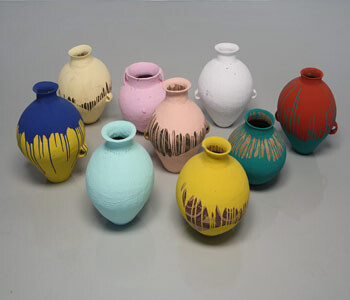Through April 18, 2010
Arcadia University Art Gallery
450 S. Easton Rd.
Glenside, Pennsylvania 19038
215-572-2131 (2133)
http://www.arcadia.edu/gallery
“Ai Weiwei: Dropping the Urn” includes examples of Ai’s unprecedented use of Neolithic and Han dynasty vessels as readymades that the artist subjects to a variety of procedures. These include marking centuries-old clay urns with hand-painted inscriptions of the “Coca-Cola” logo, dipping them into vats of industrial paint, smashing them on the ground in performances for the camera, and grinding the vessels into powder. Writing in the exhibition’s catalog essay about Ai’s “gestural practice” of defacing and destroying of these ancient objects to transform them into works of contemporary art, Beijing-based critic Philip Tinari remarks that these works provide “the illusion of clarity alongside the persistent specter of ambiguity.” What appears at first “like the sublimation of an ancient object’s financial value and cultural worth into a different yet parallel carrier of updated value and worth” also serves as a “satire of the ruling regime’s approach to its patrimony, and of contemporary China’s curious relation to its past, a situation where destruction of historical artifacts happens almost daily.”
The exhibition will also showcase replicas appropriating Qing dynasty porcelain commissioned by the artist from craftsmen in the town of Jingdezhen, where porcelain has been produced for the past 1700 years. The largest piece in the exhibition appears to be a conical pile sunflower seeds, a common street snack in China. Each “seed” however, is painstakingly handcrafted from porcelain. Weighing precisely one ton, the mound’s resemblance to minimalist sculpture and the free takeaways of Felix-Gonzales Torres is contradicted by its profligate expenditure of manual effort as well as a reference to a line of communist propaganda suggesting that the Chinese people were sunflowers following Mao Zedong. As a group, the selected examples show Ai working through the dynastic progression of Chinese ceramics to reconcile the formal, material logic and historical, political commentary that give his work its unique mixture of gravity and wit.
The exhibition will be accompanied by a fully-illustrated catalog featuring essays by Glenn Adamson, Dario Gamboni, Stacey Pierson, and Philip Tinari. Produced in collaboration with Office for Discourse Engineering, a Beijing-based editorial studio, it will be distributed in the U.S. by RAM Publications.
This exhibition has been supported by The Pew Center for Arts & Heritage through the Philadelphia Exhibitions Initiative.


